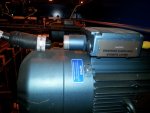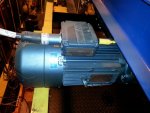factoryrat
Member
- Location
- Detroit
I am looking at a GM420 Digital Ground Continuity Relay for AC Systems made by Bender.
http://www.bender-in.com/fileadmin/products/doc/GM420_DB_en.pdf
The literature says the GM420 is a Loop Monitor to monitor the PE conductor in AC systems. One of my questions is: What is the ?PE conductor?? Is that a fancy way of saying the ground wire / circuit?
My main problem is I need to monitor whether a power cable is connected to a Motor. You see, the 480 Volt AC power feed cable has Quick Disconnects on both ends of cable and can be easily disconnected. The 4 wire, 3-phase, 480v cable is fed from a VFD and supplies a motor. The VFD does not monitor whether this cable is connected or not; but, I need to know before I release the brake on motor. Without the power cable connection I have no power on the motor (therefore no torque). VFD will release brake and load will fall.
I was wondering if I could use the GM420 relay to monitor the ground loop of the cable to determine if power cable is connected or disconnected from motor? In other words, I would use the GM420 as a "cable connection monitor" and use the relay to provide an interlock signal that would let me know and prevent me from releasing the motor brake when motor cable was disconnected. Any thoughts or comments are appreciated.
http://www.bender-in.com/fileadmin/products/doc/GM420_DB_en.pdf
The literature says the GM420 is a Loop Monitor to monitor the PE conductor in AC systems. One of my questions is: What is the ?PE conductor?? Is that a fancy way of saying the ground wire / circuit?
My main problem is I need to monitor whether a power cable is connected to a Motor. You see, the 480 Volt AC power feed cable has Quick Disconnects on both ends of cable and can be easily disconnected. The 4 wire, 3-phase, 480v cable is fed from a VFD and supplies a motor. The VFD does not monitor whether this cable is connected or not; but, I need to know before I release the brake on motor. Without the power cable connection I have no power on the motor (therefore no torque). VFD will release brake and load will fall.
I was wondering if I could use the GM420 relay to monitor the ground loop of the cable to determine if power cable is connected or disconnected from motor? In other words, I would use the GM420 as a "cable connection monitor" and use the relay to provide an interlock signal that would let me know and prevent me from releasing the motor brake when motor cable was disconnected. Any thoughts or comments are appreciated.





